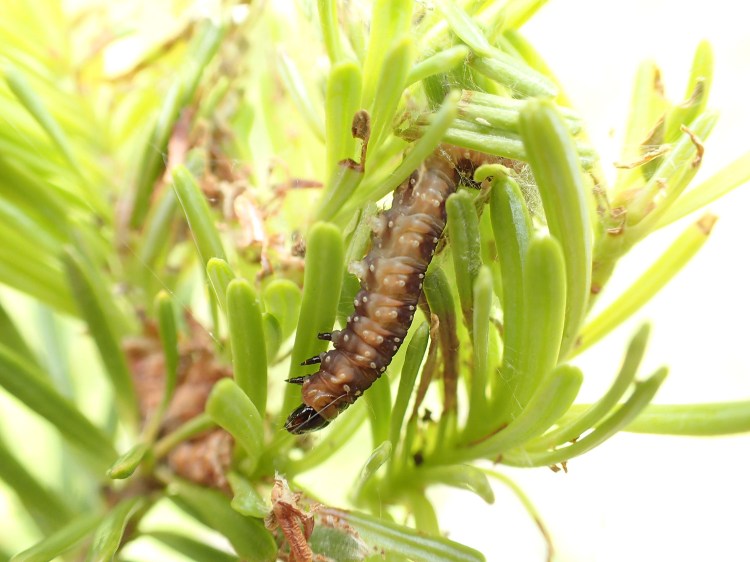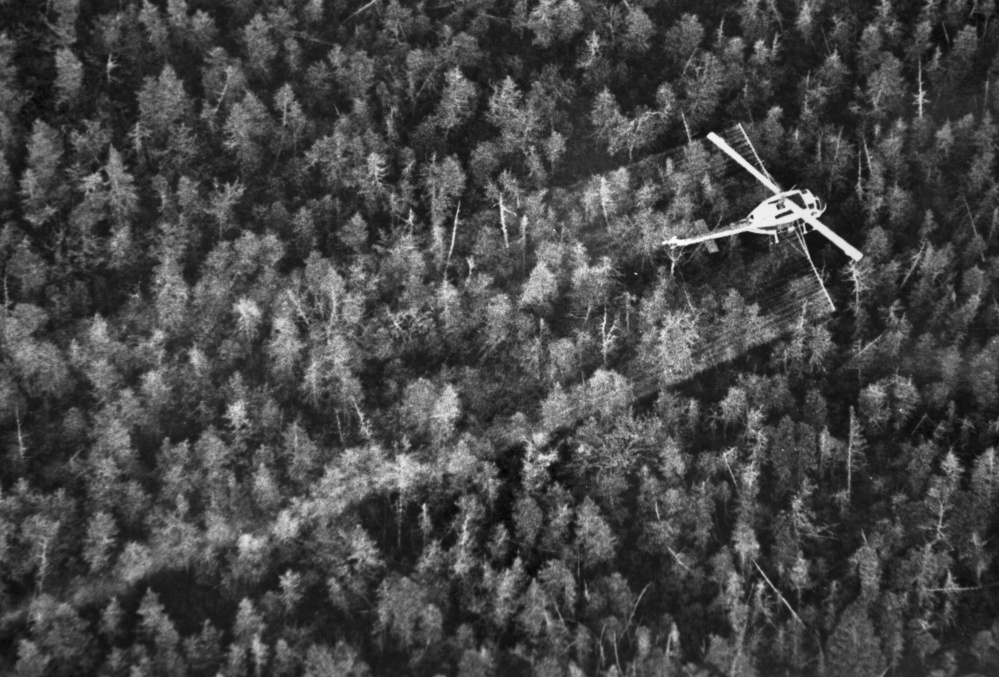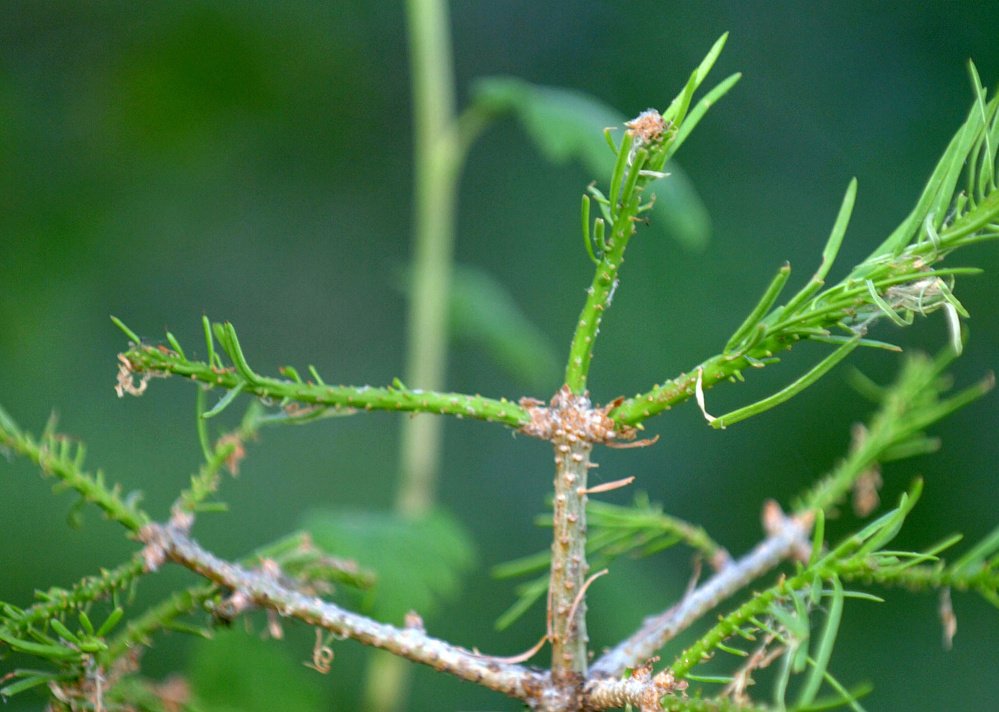AUGUSTA — Maine forestland owners are better positioned to cope with the next spruce budworm outbreak but will have to adapt their harvesting and marketing practices to deal with a pest that has already defoliated 15 million acres in Canada.
Those are some of the conclusions of a 77-page report released Wednesday on how the state is preparing for the next cyclical infestation of a pest that could cause severe economic damage to the state’s forest products industry.
Described as the most damaging forest insect in North America, the spruce budworm is not yet killing trees in Maine. However, the number of adult moths showing up in detection traps is rising. Meanwhile, the line of “severe defoliation” caused by the insects is just 50 miles from the Maine border and creeping closer.
“We don’t know exactly where, and we don’t know exactly how bad it is going to be,” Maine state entomologist Dave Struble said of the impending budworm outbreak. “But it would be naive to assume that we are not going to be looking at it, I would say, in the next couple of years.”
During Maine’s last outbreak in the 1970s and 1980s, the budworm decimated the equivalent of 20 million to 25 million cords of wood, or 21 percent of the state’s spruce and fir. The extensive defoliation prompted landowners and the state to clear-cut large areas or apply huge amounts of insecticides, which in turn led to public outcry and major changes to Maine’s forest practices laws.
Maine could lose from 247,000 to 494,000 cords of wood annually – depending on the extent of the outbreak – if steps are not taken to mitigate the losses through active management, according to the report released Wednesday. That would translate into an economic impact of between $397 million and $794 million per year, with job losses estimated at between 598 and 1,196 positions annually.
The report, compiled by a task force of state foresters, university researchers and industry representatives, lays out 70 recommendations, some of which are already being implemented. They include:
• Identifying higher-risk stands of trees now in order to harvest more trees now or plan for insecticide applications.
• Increasing monitoring and surveys for the spruce budworm, coupled with a public education campaign.
• Preparing action plans to harvest trees expected to be lost during the outbreak, either before or after defoliation.
• Encouraging new markets for lower-value, salvaged trees.
• Exploring potential policy changes to allow landowners to cut more heavily in high-risk areas – without violating the current, strict rules on clear-cuts put in place after the last outbreak – and to allow insecticide application across large areas.
LEARNING FROM EXPERIENCE
Task force members contrasted the pro-active approach advocated in the report to what they portrayed as the reactive and uncoordinated response during the early years of the last outbreak.
“The thing I am most proud of is that we all came together, had critical conversations and prepared a detailed plan before the first tree was defoliated in the state,” said Robert Wagner, professor and director of the University of Maine’s Center for Research on Sustainable Forests. “We hope this report will allow Maine to learn from past successes, avoid previous mistakes and take advantage of the many new opportunities that are out there.”
Maine’s forests are different and more diverse today than in the 1970s. Spruce and fir account for roughly 70 million cords today, compared with 130 million cords that were “on the stump” at the onset of the last budworm outbreak. Additionally, Maine’s commercial forests are more accessible via a vast network of logging roads that did not exist 40 years ago, thereby allowing for more targeted harvesting or localized pesticide application.
But today’s markets present additional challenges as well.
The closures of pulp and paper mills in Millinocket, Bucksport, Old Town and soon in Madison have shrunk the market for spruce and fir wood, raising questions about where landowners will send their wood. Maine Forest Service Director Doug Denico acknowledged he was concerned about the implications of those rapid changes in Maine’s pulp and paper industry.
“We’ve gone from good markets in two years … to now we are kind of scratching our heads about where we are going to market this stuff,” Denico said. “I am personally looking at the sawmills to hopefully fill in the gap that has been created with the pulp mills (closing).”
Asked what Mainers are likely to see during the outbreak, Denico said he expects the impact on the landscape to be less dramatic than during the last outbreak because of more targeted harvesting.
“Will there be more clear-cutting than probably there has been in the last 10 years? If we have an infestation, then the answer is yes,” Denico said. “But it will be targeted to stands … that are very vulnerable to the budworm.”
Several conservation groups involved in policy debates on Maine’s commercial forests praised the report Wednesday.
“I think seeing is believing, but thus far I am impressed with the response that I have heard,” said Eliza Donoghue, the North Woods policy advocate for the Natural Resources Council of Maine.
TARGETED USE OF FOREST PESTICIDES
The Maine chapter of The Nature Conservancy has already started prepping for the budworm’s arrival on the roughly 160,000 acres of forestland the organization owns in the state, much of that in the St. John Valley of northern Maine.
The Nature Conservancy, which already manages some land for timber, plans to conduct targeted harvesting in some high-risk areas but will leave other areas alone, said senior policy adviser Tom Abello. The organization currently has no plans to use pesticides to try to control the budworm, however.
Unlike during the 1970s and 1980s, when the state and federal governments played a large role in coordinating and financing budworm insecticide applications, private landowners are expected to assume those responsibilities during the upcoming outbreak. The report states that wood supply models indicate no more than 20 percent of an infested area would need to be treated with one type of insecticide “to achieve near-maximum benefit if the coming outbreak is as severe as the one in the 1970s.”
Abello said he believes more landowners will use targeted forest management rather than the mass spraying seen during the last outbreak. And while he said the impact of the outbreak remains unclear, he was pleased with the task force’s work and believes the state has learned from the experiences of the 1970s.
“It’s good that the state is getting out there and being prepared, and I think it’s good that the report had input from a lot of different sectors,” Abello said.
The complete report is available online at sprucebudwormmaine.org.
Send questions/comments to the editors.






Success. Please wait for the page to reload. If the page does not reload within 5 seconds, please refresh the page.
Enter your email and password to access comments.
Hi, to comment on stories you must . This profile is in addition to your subscription and website login.
Already have a commenting profile? .
Invalid username/password.
Please check your email to confirm and complete your registration.
Only subscribers are eligible to post comments. Please subscribe or login first for digital access. Here’s why.
Use the form below to reset your password. When you've submitted your account email, we will send an email with a reset code.